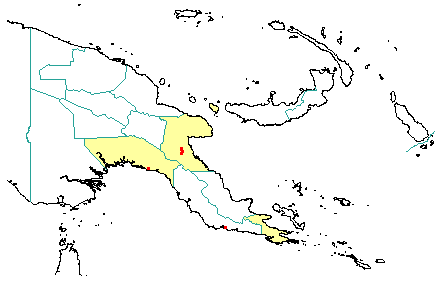
in PNGplants database
PNGTreesKey – Drypetes lasiogynoides Pax & K.Hoffm. |
Barry Conn (NSW) & Kipiro Damas (LAE).
Guide to trees of Papua New Guinea
Copyright held by the authors, National Herbarium of New South Wales, and Papua New Guinea National Herbarium
in Engler, H.G.A., Das Pflanzenreich 272 (1922)
Family: Putranjivaceae
Dicotyledon
Timber Group: Minor hardwood
Field Characters: Large canopy tree (up to c. 20 m high) or Small sub-canopy tree; Bole cylindrical (20-30 cm diam.); straight (bole 8-15 m long); buttresses buttresses absent; spines spines absent; aerial roots aerial roots absent; stilt roots stilt roots absent; Bark grey, rough, scaly or flaky or fissured; Subrhytidome (under-bark) yellow or green; less than 25 mm thick, 4.0-6.0; bark blaze consisting of one layer; faintly to non-aromatic; outer blaze white or pale yellow, markings absent; inner blaze white or pale yellow, markings absent; bark exudate (sap) present, colourless, not readily flowing (spotty), colour not changing on exposure to air, not sticky; terminal buds not enclosed by leaves.
Indumentum: Complex hairs absent; stinging hairs absent; mature twig indumentum (hairs) absent.
Leaves: Leaves spaced along branches, spiral (leaves occurring singly at a node and arranged spirally up the branchlet), simple (a leaf composed of a single blade) (frequently taste peppery or slightly radish-like); petiole present, not winged, attached to base of leaf blade, not swollen; leaves broadest at or near middle, 8.5-11.0 cm, 3.5-5.0 cm; symmetric (to slightly asymmetric), entire, not dissected or lobed, obtuse or sub acute, venation pinnate, secondary veins open, prominent, intramarginal veins absent; leaves lower surface green, upper surface dark green (glossy), indumentum (hairs) absent; absent; domatia absent; stipules absent.
Flowers: Inflorescence axillary, flowers arising from a single point, cones absent; flowers unisexual, unisexual with male and female flowers on different plants, stalked, flowers with many planes of symmetry, 6.0-8.0 mm long, diameter small (up to10 mm diam.) (4-5 mm diam.); perianth present, with all sepals and/or petals (hence tepals) similar or petals absent, inner perianth pale yellow or cream-coloured; 4-5, free or some or partly joined (at base); stamens 100, present, free of each other, free of the perianth; ovary superior, carpels joined (when more than one), locules 1; styles absent.
Fruits: Infrutescence arising from single point, fruit 12.0-25.0 mm long, orange (often with red dots) or red, not spiny (mealy), fleshy, simple, indehiscent, drupe; seeds 1, about 10 mm long, not winged, broad (as wide as long), seed 1-10 mm diam.
Distribution: Morobe, Gulf & Milne Bay.
 | Botanical records in PNGplants database |
Notes: Notes Drypetes has usually been included in Euphorbiaceae (in subfamily Phyllanthoideae).